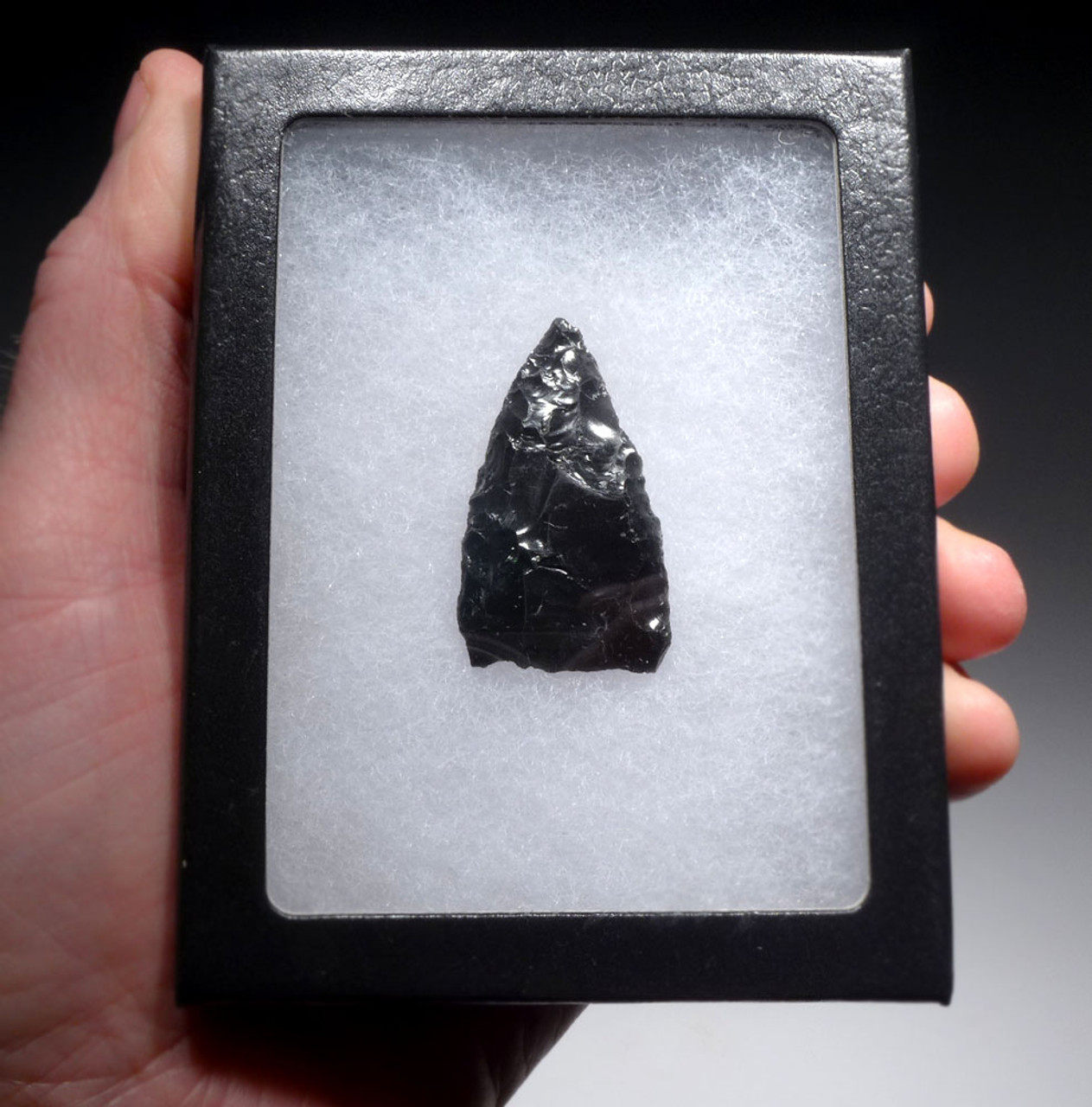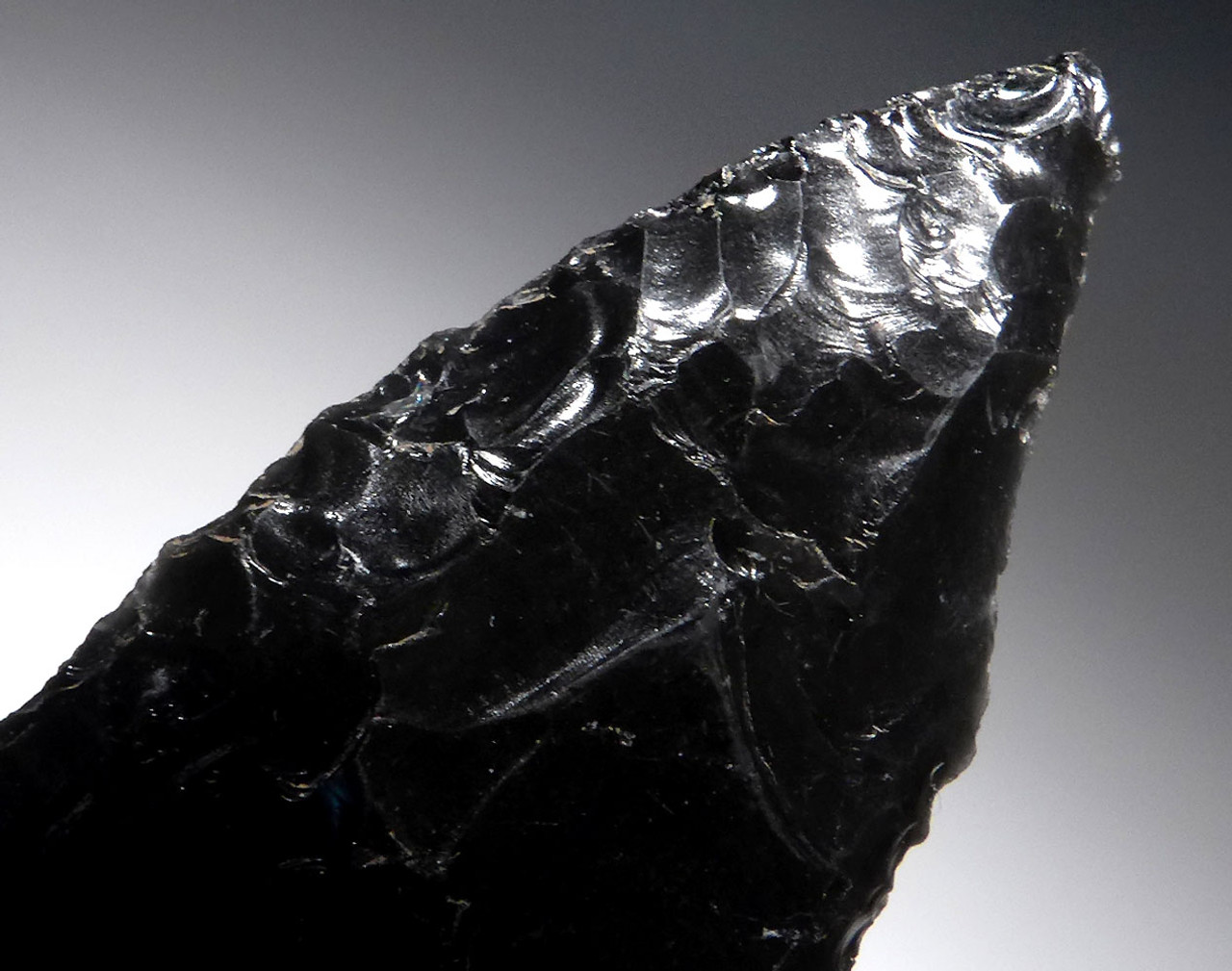Product Description
SEE MORE PRE-COLUMBIAN ARTIFACTS
The famous and enigmatic Nazca lines and giant ancient anthropomorphic figures drawn in the Ica Desert of Peru, are one of humanity's greatest mysteries to this day. This region, once inhabited by the Nazca Pre-Columbian Indians from 100 BC to 800 AD, is surrounded in tales of extra-terrestrial contact. Why would you make giant figures that could only be viewed by a high aerial perspective if there was no technology to view these figures? What could have made so many of the Nazca lines that run perfectly straight for extreme distances, many running straight off of a cliff? It is no wonder that many believe that the Nazca Indians had contact with ancient extra-terrestrials when you see these amazing features in the desert. Their bizarre practice of deforming their skulls to alien-like elongated forms, only adds to this mystery!
This is a RARE obsidian bifacial atlatl spearhead from the Pre-Columbian Nazca (or Nasca) Culture. It displays expert flaking and a thin profile. The size and type of this projectile dart point indicates it was hafted on to a spear shaft and launched by an atlatl thrower. Weapons from the Nazca culture are extremely rare and the acquisition of a few of these points from a single German private collection has been our only opportunity in 36 years of business, to be able to offer these here.
Mineral and sediment can be seen deep in flake scars which are indicators ONLY found in AUTHENTIC specimens such as this. Caution must be applied in acquiring ancient obsidian artifacts because the stone does not patinate on the surface like other lithic types.
Obsidian was prized by the ancient Pre-Columbian Indians and even today, it is still used in modern medicine for scalpel blades as obsidian can flake to an edge one molecule thick, thereby attaining a level of sharpness impossible to achieve with a steel scalpel. As a matter of fact, aside from using lasers in modern surgery, the preferred scalpel is one from obsidian. Because of its sharpness, obsidian leaves less of a scar and does less tissue damage than a scalpel or knife made of any other substance known. Obsidian flaked edges are 15 times sharper than sharpened edges of surgical steel! It’s no wonder that obsidian became a valuable tool in medicine and warfare. Common household razor blades are 100 times thicker than obsidian can be flaked to!
The Atlatl or Spear (Dart) Thrower was a weapon used by all Pre-Columbian cultures from South and Central America. It launched a spear tipped with a projectile point, with greater force and to greater ranges than could be thrown by hand. Warriors would carry the atlatl and about three to five throwing darts which they would launch as they advanced into battle before engaging into melee combat. The "darts" launched from an Atlatl were more like big arrows about 5.9 feet long, and were tipped with obsidian, chert, bone or copper heads.
HISTORY
The Nazca culture (also Nasca) was the archaeological culture that flourished from c. 100 BC to 800 AD beside the arid, southern coast of Peru in the river valleys of the Rio Grande de Nazca drainage and the Ica Valley. Strongly influenced by the preceding Paracas culture, the Nazca produced an array of crafts and technologies such as ceramics, textiles, and geoglyphs. Some macabre practices the Nazca were notorious for were headhunting and skull trepanation, as well as deformation and elongation of the skulls of living people, to produce bizarre, alien-like appearances.
They are known for two extensive construction projects that would have required the coordination of large groups of laborers: the Nazca Lines, immense designs in the desert whose purpose is unknown, and puquios which are underground aqueducts for providing water for irrigation and domestic purposes in the arid environment. Several dozen still function today. The Nazca Province in the Ica Region was named for this people.
Early Nazca society was made up of local chiefdoms and regional centers of power that developed around Cahuachi, a non-urban ceremonial site of earthwork mounds and plazas.
Nazca religious beliefs were based upon agriculture and fertility. Much of Nazca art depicts powerful nature gods, such as the killer whale, the harvesters, the mythical spotted cat, the serpentine creature and the most prevalent of worshipped figures, the anthropomorphic mythical being. Shamans apparently used hallucinogenic drugs, such as extractions from the San Pedro cactus, to induce visions.
The Nazca were prolific headhunters. The Nazca used decapitated heads, known as trophy heads, in various religious rituals and appear as a motif in ceramic iconography. Visual depictions of decapitations often associate the decapitators with weapons and military-like dress, but such garments could have been worn in purely ceremonial circumstances as well.
The term 'trophy head' was coined by archaeologist Max Uhle, who considered the depiction of severed heads in ancient Peruvian art to correspond to trophies of warfare. Researchers noted that all the heads had one modification in common- a hole in the forehead through which a rope could be affixed, presumably so that the severed head can be displayed or carried. Other common modifications were the base of the skull being broken and thorns closing the mouth. Over 100 heads that have been discovered were mummified which was a practice unique to the Nazca, and the preceding Paracas Culture.
Trephination was a primitive skull surgery used by the Nazca, seen through the analysis of excavated skulls. The practice was believed to relieved pressure on the brain from battle wounds, or for ritual purposes. It entails the removal of one or more sections of bone from the skull (while the person is still alive). Some of the skulls show signs of healing, evidence that the person had survived the operation.
Elongated skulls, as a result of skull manipulation, were also seen in the excavations from Cahuachi. The strange effect was achieved by binding a cushion to an infant's forehead and a board to the back of the head. Archaeologists can only speculate as to why this was done to some of the skulls. Several theories suggest skull manipulation created an ethnic identity, formed the individual into a social being, or may have illustrated social status.
 US DOLLAR
US DOLLAR
 EURO
EURO
 AUSTRALIAN DOLLAR
AUSTRALIAN DOLLAR
 CANADIAN DOLLAR
CANADIAN DOLLAR
 POUND STERLING
POUND STERLING










